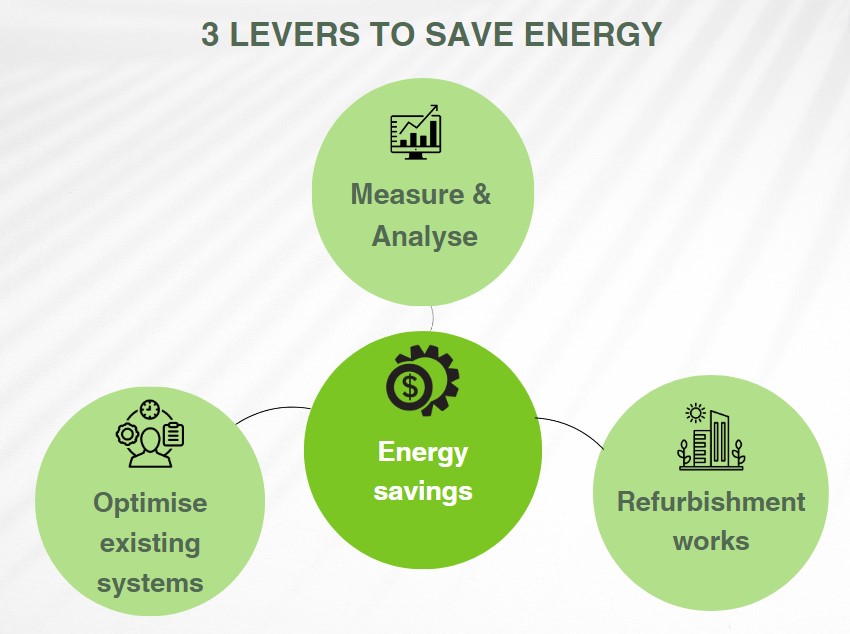
How to save energy in commercial buildings in the UK?
Why is it important to save energy in commercial buildings now?
Energy savings have never been so relevant in the commercial real estate sector, for several reasons, including economic, environmental, and social considerations. Occupiers are increasingly demanding buildings with high environmental credentials, ESG-requirements creates a pressure from investors to evolve towards a decarbonising buildings approach and the clock to net zero is ticking in the UK. May 2022 saw the launch of the industry-led UK Net Zero Carbon Buildings Standard which aims to assess and certify buildings in line with science-based net-zero targets by 2050.
There are several ways to save energy in commercial buildings depending on your goals and the time scales involved.
Three types of actions to save energy in commercial buildings.
Each action includes varying levels of investment and different timeframes for returns on investment:
- Optimising Existing Systems (Low or No Investment, Rapid ROI): These actions focus on improving the efficiency of the current building systems without significant capital expenditure.
- Implementing Control and Automation (Medium-Term ROI): These actions involve the installation of control systems and automation technologies to better manage and optimise energy use.
- Replacing Equipment and Insulation (Long-Term ROI): These actions require significant upfront investment but offer substantial energy savings over the long term.
The choice of actions will depend on the specific needs, budget, and goals of the commercial building owner or operator. Often, a combination of these approaches is used to achieve the greatest energy savings and return on investment.
First type of actions: optimisation of the energy use in commercial buildings
Energy optimisation of the existing system consists of better managing existing equipment in line with the needs of the occupants and the operating constraints of the building. For example, this involves:
- Encouraging occupants to adopt energy-saving habits, such as turning off lights and equipment when not in use.
- Regular maintenance and fine-tuning of Heating, Ventilation and Air-Conditioning (HVAC), lighting, and other systems to ensure they operate at their peak efficiency…
These actions can, on the one hand be carried out via existing control systems such as time clocks or technical building management systems which can be programmed. Occupiers also have an important role in these actions to control uses in offices (lighting, IT, temperature, etc.).
Having educational data on the actual energy use of the building is essential to target optimisations, share them with stakeholders and monitor the results of the actions carried out, then lead a long-term approach to sustain these energy savings.
These actions require little or no investment, on average achieving 10 to 15% energy savings with returns on investment of less than one year.
Case study for optimising the consumption of a 10,000 sqm office building:
To download the full case study: click here
Second type of actions: the implementation of equipment control systems
Investing in an EMS system for your building, which monitors and controls HVAC, lighting, and other systems in response to occupancy and external conditions, can result in savings of up to 30% compared to buildings lacking an efficient equipment management strategy.
For instance, implementing various measures such as installing occupancy sensors for automatic light control, incorporating variable-speed motors in air handling units, or upgrading to smart thermostats that enable programmable and remote temperature management. These initiatives enable equipment to adapt its operation and, consequently, its energy consumption to real-time requirements, such as lighting and ventilation.
Typically, such actions can yield a return on investment in about five years, contingent on the existing circumstances. Furthermore, the availability of precise data on the building’s energy usage is essential to ensure the effectiveness of complex control strategies and to maximise system performance.
Third type of actions: replace equipment and insulate the building
The third category of actions demands greater initial investment, but it enables you to attain peak performance levels. This category encompasses various strategies, such as upgrading equipment for improved efficiency. The inherent efficiency of these upgraded systems can substantially reduce consumption while maintaining equivalent usage levels. For instance:
- HVAC System Upgrades: Swapping out older, inefficient HVAC systems for high-efficiency models or adopting geothermal and solar heating and cooling solutions.
- Lighting Enhancements: Substituting conventional lighting with energy-efficient LED or CFL fixtures.
- Building Envelope Improvements: Enhancing insulation, windows, and doors to curtail heat transfer and minimise energy losses.
Although these investments typically involve substantial initial costs and are often integrated into broader real estate projects, they can lead to impressive energy savings ranging from 40% to 50%. The returns on investment tend to be long-term, with payback periods spanning from 5 to 25 years.
Furthermore, utilising consumption data by specific use can prove invaluable for crafting precise work plans and accurately quantifying the returns on investments based on actual consumption patterns. This data can also serve to validate the performance and operation of the installed systems.
These 3 types of actions complement each other to effectively save energy in commercial buildings.
Achieving peak performance involves the synergy of three key elements: the efficient operation of high-performance equipment through strategic control, the conscientiousness of users in properly insulated buildings.
Implementing a singular type of action may not suffice, as the installation of highly capable yet poorly calibrated equipment can lead to excessive energy consumption compared to a baseline scenario.
To guarantee the efficacy, proper sizing, and long-term sustainability of such actions, it is imperative to monitor energy consumption closely using informative data.
Do you also want to analyse your electrical uses to target and monitor energy savings?




